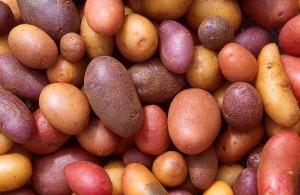 I graduated from Voronezh State Agrarian University. CD Glinka, agronomic faculty in the specialty fruit vegetable and viticulture. For a long time I am a fan of your publication, but I decided to write for the first time. In the 2nd issue published article S.N. Shootova from Kuznetsk "times potatoes, two potatoes ...". I do not quite understand the table, namely, what is the third (average yield, kg / bush) and the fifth (weight from the bush, kg) columns? Take, for example, the string is the first:
I graduated from Voronezh State Agrarian University. CD Glinka, agronomic faculty in the specialty fruit vegetable and viticulture. For a long time I am a fan of your publication, but I decided to write for the first time. In the 2nd issue published article S.N. Shootova from Kuznetsk "times potatoes, two potatoes ...". I do not quite understand the table, namely, what is the third (average yield, kg / bush) and the fifth (weight from the bush, kg) columns? Take, for example, the string is the first:
Potatoes grade Zhukovsky Early, the average yield of 1.1 kg from the bush with the number of tubers from 12 to 15. If you make simple arithmetic calculations, it turns out that the tuber must weigh from 73 to 91 grams. It suggests that it is not a potato, and "peas", and is it worth a shorter with potatoes since February of the month?
Or take another line: grade duckling, the average yield is 0.6 kg from the bush, and in the fifth column weight from the bush 0.7-1.2 kg. How can the average yield with sob
That lower than the minimum weight from the bush? Like shoes, I also want to get a record potato harvests, but those labor costs, time and strength that the author carries, just monstrous! Washing potatoes - it can still be understood, but why to miss it with green? How many potatoes the author uses for landing (number of pieces and total weight)? As you already understood, after reading this article, I had a huge number of questions. I also grow potatoes. I would like to share the results of last year's experiment. In my opinion, the yield of potatoes depends on several factors: high-quality planting material, fertilizer, watering, as well as regular weeding and dip.
April 16 acquired in a specialized economy seed potatoes of varieties of the Dutch selection of Laton, Romano, Picasso, 2 kg of each variety. Potatoes was not large (25-55 g). Total It turned out: 51 Laton Early Sorts Nights, 51 - Romano, Aa - Late Picasso. Sent potatoes on April 25 without a long germ and landscaping according to the 60 × 80 (90) scheme (90) see. Total experimental plantation has occupied 78 square meters. M (24 sq. M. M Picasso, by 27kv. M Laton and Romano) When landing, I made 4 kg of azophoski as the main fertilizer (at the rate of 500 g per 10 sq. M), 480 g of potassium chloride and 1.6 kg of superphosphate. Earth in my area is not fertile - solid sand, so you have to carefully take care of the nutrition of plants. May 11 appeared
The first shoots. When the potato shoots have reached a height of 15-20 cm, I conducted the first feeding fertilizer: 2 kg of azophoski, 400 g of potassium chloride. Fertilizer brought into a row of an axer, followed by extracting. A week later, he spent an extraordinary feeder with microfertilizers: Boric acid (5-10 g per bucket of water) and magnesium sulphate (200 g per bucket of water).
I spent the last feeder during the bootonization period: 2 kg of azophoski, 400 g of potassium chloride. Fertilizer brought into a row of an axer, followed by extracting. P with a strong drought 0 and the absence of rain several times over the summer watered in rows.
Picasso.
To protect against Colorado, the beetle processed a fungicide in accordance with the instructions. To protect against phytophors, 2 times the season was treated with a copper-containing drug.
The difference in the yield of Picasso and Romano I can explain the low quality of the planting material. At the Romano variety with potatoes, we found a clear auction, which caused a harvest undepers. Based on the experience of 2009, I concluded about the importance of high-quality seed.
If you consider yield from one nest, I evaluate it as beautiful. If you recalculate the yield per 1 weave, then the yield is 310 kg from the weave - not the limit for varieties of Dutch selection, which have a very high potential yield.
This year I plan to carry out a more dense landing (40 × 70 cm).
Varieties of potatoes
Comments leave a comment
 Start a discussion ...
Start a discussion ...












